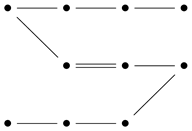Bratteli Diagrams, Hopf–Galois Extensions and Calculi
Abstract
1. Introduction


2. Preliminaries
3. A Bratteli Diagram Which Is Not a Hopf–Galois Extension

4. Combining Matrices on Block Diagonals
- Case 1:
- Case 2:
- Case 3:
5. Block Matrices and Quantum Principle Bundles
- Case 1:
- Case 2:
- Case 3:
6. Strong Universal Connection
7. A Trivial Quantum Principle Bundle
8. Consequences for Differential Calculus
9. Concluding Remarks
Author Contributions
Funding
Data Availability Statement
Acknowledgments
Conflicts of Interest
References
- Schneider, H.-J. Principal homogeneous spaces for arbitrary Hopf algebras. Isr. J. Math. 1990, 72, 167–195. [Google Scholar] [CrossRef]
- Brzeziński, T.; Majid, S. Quantum group gauge theory on quantum spaces. Commun. Math. Phys. 1993, 157, 591–638, Erratum in Commun. Math. Phys. 1995, 167, 235. [Google Scholar] [CrossRef]
- Brzeziński, T.; Majid, S. Quantum group gauge theory on classical spaces. Phys. Lett. B 1993, 298, 339–343. [Google Scholar] [CrossRef]
- Chase, S.U.; Sweedler, M.E. Hopf Algebras and Galois Theory; Springer: Berlin/Heidelberg, Germany, 1969. [Google Scholar]
- Kreimer, H.F.; Takeuchi, M. Hopf algebras and Galois extensions of an algebra. Indiana Univ. Math. J. 1981, 30, 675–692. [Google Scholar] [CrossRef]
- Montgomery, S. Hopf Galois theory: A survey. Geom. Topol. Monogr. 2009, 16, 367–400. [Google Scholar]
- Bratteli, O. Inductive limits of finite dimensional C*-algebras. Trans. Am. Math. Soc. 1972, 171, 195–234. [Google Scholar] [CrossRef]
- Majid, S. Cross product quantisation, nonabelian cohomology and twisting of Hopf algebras. In Generalized Symmetries in Physics; Doebner, H.-D., Dobrev, V.K., Ushveridze, A.G., Eds.; World Scientific: Singapore, 1994; pp. 13–41. [Google Scholar]
- Brzeziński, T.; Majid, S. Quantum geometry of algebra factorisations and coalgebra bundles. Commun. Math. Phys. 2000, 213, 491–521. [Google Scholar] [CrossRef]
- Beggs, E.J.; Majid, S. Quantum Riemannian Geometry; Grundlehren der Mathematischen Wissenschaften; Springer: Berlin/Heidelberg, Germany, 2020; Volume 355. [Google Scholar]
- Hajac, P.M. Strong connections on quantum principal bundles. Commun. Math. Phys. 1996, 182, 579–617. [Google Scholar] [CrossRef]
- Beggs, E.J.; Brzezinski, T. An explicit formula for a strong connection. Appl. Categ. Struct. 2008, 16, 57–63. [Google Scholar] [CrossRef]
- Aschieri, P.; Landi, G.; Pagani, C. Braided Hopf Algebras and Gauge Transformations II: *-Structures and Examples. Math. Phys. Anal. Geom. 2023, 26, 13. [Google Scholar] [CrossRef]
- Ćaćić, B.; Mesland, B. Gauge Theory on Noncommutative Riemannian Principal Bundles. Commun. Math. Phys. 2021, 388, 107–198. [Google Scholar] [CrossRef]
- Postnikov, M.M. Determination of the homology groups of a space by means of the homotopy invariants. Dokl. Akad. Nauk. SSSR 1951, 76, 359–362. [Google Scholar]
- Gong, G.; Jiang, C.; Li, L. A classification of inductive limit C*-algebras with ideal property. Trans. Lond. Math. Soc. 2022, 9, 158–236. [Google Scholar] [CrossRef]
- Connes, A. Non-commutative differential geometry. Pub. Mathématiques L’Institut Hautes Sci. 1985, 62, 41–144. [Google Scholar] [CrossRef]
Disclaimer/Publisher’s Note: The statements, opinions and data contained in all publications are solely those of the individual author(s) and contributor(s) and not of MDPI and/or the editor(s). MDPI and/or the editor(s) disclaim responsibility for any injury to people or property resulting from any ideas, methods, instructions or products referred to in the content. |
© 2025 by the authors. Licensee MDPI, Basel, Switzerland. This article is an open access article distributed under the terms and conditions of the Creative Commons Attribution (CC BY) license (https://creativecommons.org/licenses/by/4.0/).
Share and Cite
Alhamzi, G.; Beggs, E. Bratteli Diagrams, Hopf–Galois Extensions and Calculi. Symmetry 2025, 17, 164. https://doi.org/10.3390/sym17020164
Alhamzi G, Beggs E. Bratteli Diagrams, Hopf–Galois Extensions and Calculi. Symmetry. 2025; 17(2):164. https://doi.org/10.3390/sym17020164
Chicago/Turabian StyleAlhamzi, Ghaliah, and Edwin Beggs. 2025. "Bratteli Diagrams, Hopf–Galois Extensions and Calculi" Symmetry 17, no. 2: 164. https://doi.org/10.3390/sym17020164
APA StyleAlhamzi, G., & Beggs, E. (2025). Bratteli Diagrams, Hopf–Galois Extensions and Calculi. Symmetry, 17(2), 164. https://doi.org/10.3390/sym17020164





